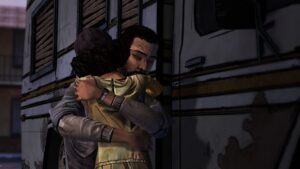
Suffice it to say that narrowing down the video game literary canon to just five games for a semester is taxing. There are so many games out there with fabulous stories, trying new things and pushing literary mechanics to their limits. But however wonderful, visionary, or progressive they may be, they’re not all right for the classroom.
So, how did I narrow it down?
For Fall 2021, I wanted to focus on historical importance in context of story-based games. That means choosing games that were the first of their kind to try something, or at least try it well, or games that had a significant impact on video game story-telling culture. Games that were, essentially, ahead of their time.
And of course, they all had to have strong literary elements.
Another thing I had to consider was time. I can only assign 90 hours of homework in 15 weeks for a 3 credit hour class. And while video games should be the bulk of that work for analysis purposes, other assignments also need to be completed to expand knowledge and assess objectives. There are certainly amazing games that we could spend over 90 hours playing, just on their own! I had to also try to balance time with variety. There are a great number of concepts to discuss when we talk about games as literature, and not all of these concepts are best explored in the same type of game.
So I needed meaningful games, that wouldn’t take so long to play that we couldn’t get a variety. And we of course still need time to write.
Cost and equipment is another consideration. Many students taking the class don’t have a console. And even if they do, they don’t all have multiple consoles. And even if they have multiple consoles, they still might not have the *right* console. So any game I chose had to ensure that any student could play, without having to make a costly purchase. And since I wanted to play mulitple games, I also wanted to ensure that the games themselves were not all going to cost $60 each.
Even with these restrictions, there were still a great selection of games to choose from — that said, these restrictions might explain why a game you were hoping to read about or play didn’t make the cut.
So why these five?
What Remains of Edith Finch is a simple game in terms of actual game play, making it an easy game to break in students not familiar with playing video games. That said, its ease of use says nothing of its emotional and literary depth. One of its levels has been touted as one of the best levels ever designed in video games. It’s use of mechanics as devices for telling story are also remarkable and ahead of its time in some ways. It’s also a much newer game; the newest on the list, giving us a clear sense of where games are now and where they might be headed.
Oh, Telltale. If you’re looking for story-driven games, Telltale has always been ahead of its time here. Even if they did go out of business. While not the best rendition of, well any game, even their early Back to the Future based games were lauded for their sophisticated, nuanced, and on point dialogue. Telltale’s The Walking Dead is another first of its kind done well, one that had a large impact on how people perceived games, and one which integrated directly with graphic novels (Michonne). What better setting to make morality a game than a zombie apocalypse? And I mean that sincerely (zombie moves are always more about morality than gore.). TWD’s use of NPCs to play on your heart strings and your conscious is worth serious discussion any day. It also allows us to explore the traditional approach to branching narratives, and with its final installment, season 4, available, we can look at how the game type has evolved over time. It also will allow us to touch on cinematic language in video games.
Bioshock may look a bit outdated by today’s graphic standards, but in terms of how it used player expectation and video game convention against the player narratively — it was unmatched in its time. Which still really wasn’t that long ago. It’s also an excellent study of world and theme, and gives us an opportunity to discuss how traditional literary techniques and theories can be used to build amazing games. The game was a master piece of its time, but isn’t without its quirks or mechanic drawbacks by today’s standards; regardless, its a gold-mine for literary discussion.
Following Bioshock with Bioshock Infinite not only gives us a chance to explore how franchises affect story but to also explore video games as literary criticisms! Most as you may have heard of a novel being written, not just as a story, but a critique of culture or even story-telling, Bioshock Infinite takes video games to this meta-level of commentary and dissection. I can’t say too much more without spoiling it, but suffice it to say there are very, very few games that could rival the work it does in this particular area.
One of the things we will do at the end of the class is try to identify modern games that are likely ahead of their time, right now. Games that give us a glimpse into the future. So, a lovely pairing would be going back in time, to 1995 to look at what such a game looked like then. Chrono Trigger, despite nearing 30 years old, is still listed as “the best video game of all time” by a large number of modern critics. It took story seriously in a time where story was just a backdrop for the mascott in other popular games. It used design and music to enhance that story, unlike text-based games (the go-to for story in game play at the time), and took its job seriously, with one of the best video games sound tracks still to this day. Also, though they may not look it now, those graphics were pretty bad ass in 1995. It also used mechanics to tell story and had story directly effect mechanics and levels. A lot of these things may seem common today, but they were unheard of back then. It’s also just a really solid, interactive, branching narrative. Epic, some would say. Though the longest game on the list, there is a ton to talk about here (and finishing won’t be required.).
This array of games gives us experience with dialogue based games, first person shooters, branching narratives, static narratives, and RPGs. Clearly not the full array, but more variety than if I’d chosen some other options. There is also a fairly diverse selection of themes and use of mechanics to tell story, and a wide array of tones and characters considering there are only five games, even if Bioshock and Chrono Trigger offer the most traditional MCs/PCs. I used to include Life is Strange, and strongly considered it again this semester, as it is a brave game (either season) in how it tackles modern culture and themes, but it is similar in game play to TWD, and something had to get cut time wise. Regardless, we’ll still discuss key concepts from these games in class.
We’ll also have numerous opportunities to discuss, play parts of , and explore other games during class time and students are welcome to choose a game not listed above for their analysis essay if they desire, an analysis that will be shared with the class.
There’s plenty to talk about, even more to explore. With our course selections made for the semester, all that’s left is to hit Start.
